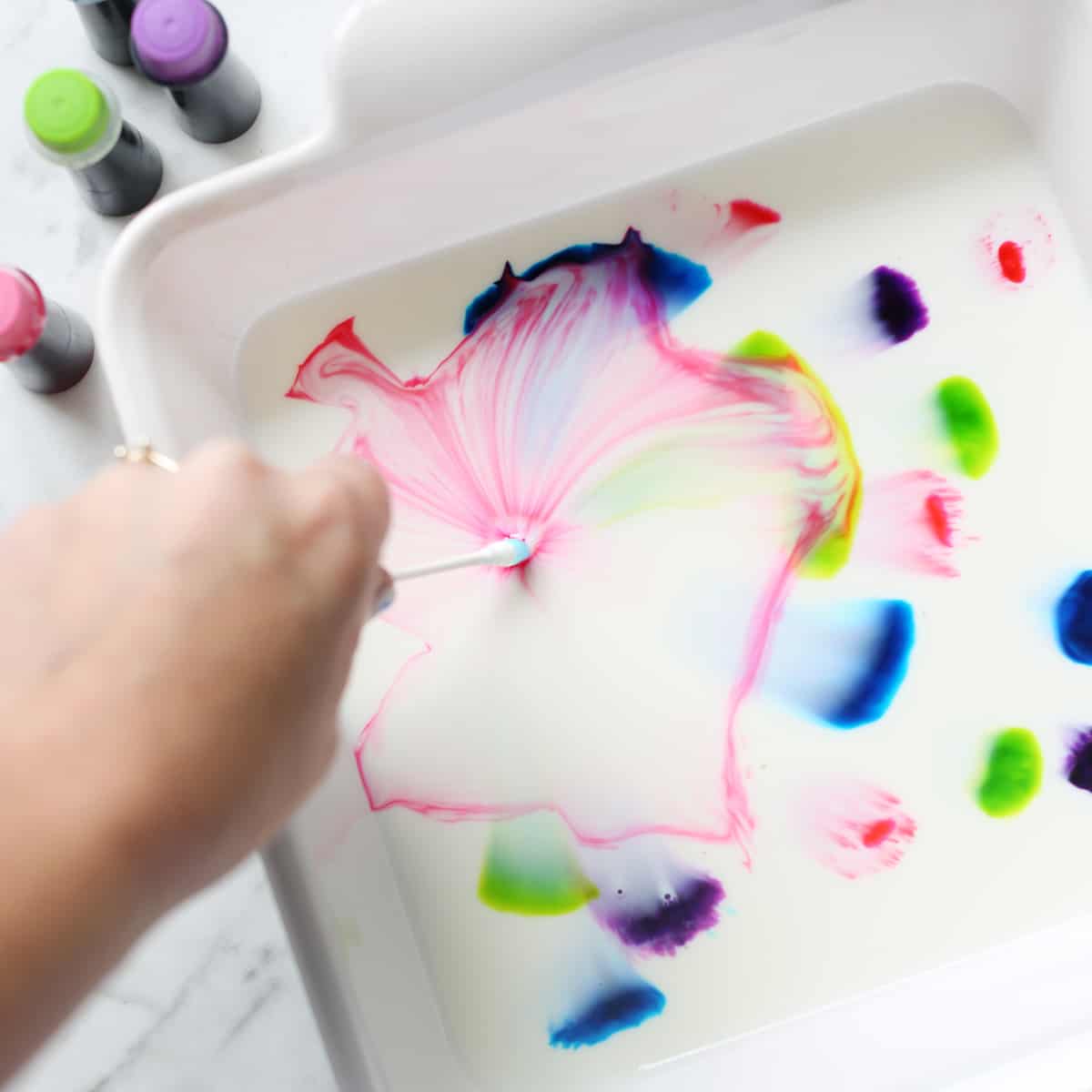Looking for an engaging and educational activity to captivate your young ones? Try milk painting—a fantastic science experiment that combines art and chemistry.
This simple experiment not only sparks creativity, but also teaches children about the properties of surface tension and the fascinating world of molecular interactions.
Related: Want more kid-friendly science experiments? Try the Bouncy Egg Experiment, Skittles Experiment, Elephant Toothpaste and more in our Activities archive.

Would you like to save this?
Below, we share step-by-step instructions on how to do the milk painting experiment, including this quick video tutorial:

Materials
- Milk
- Food coloring
- Dish soap
- Shallow container – like a baking dish or Tupperware
- Cotton swabs or balls
If you feel uncomfortable using milk (food) in this science experiment, you can wait to use milk until it has almost or just expired and may no longer be safe to consume.

Directions
Begin by pouring the milk into the shallow dish, ensuring that the milk covers the bottom evenly. You don’t need much—just a thin layer.
Add a few drops of food coloring to the milk, placing the drops near the center of the dish. Feel free to experiment with different colors and patterns!
Dip a cotton swab or cotton ball into the dish soap, making sure it is coated but not dripping. You only need a small amount.
Gently touch the soapy end of the cotton swab or toothpick to the milk, focusing on the areas where the food coloring is present. Observe the magical transformation!

What Kids Learn From This Experiment
- Surface Tension: Surface tension is the force that acts on the surface of a liquid, causing it to behave like a thin, elastic film. When you add the soap to the milk, it disrupts the surface tension, causing fascinating effects. The soap molecules break the surface tension by attaching to the fat molecules in the milk, causing them to disperse.
- Molecular Interactions: The food coloring in the experiment contains water-soluble dyes. When you add soap to the milk, the soap molecules move around and interact with the fat molecules in the milk. This interaction causes the dyes to spread and mix, resulting in vibrant, swirling patterns.
- Emulsion: The milk painting experiment showcases the creation of an emulsion, which is a mixture of two or more liquids that usually don’t blend together. In this case, the dish soap acts as an emulsifier, helping to disperse the fat molecules in the milk and allowing the food coloring to mix more easily.
- Artistic Exploration: Milk painting offers an exciting canvas for artistic expression. Children can experiment with different colors, patterns, and techniques, fostering their creativity and imagination. They can observe how the addition of soap alters the designs, giving them a hands-on understanding of cause and effect.

Milk painting is a delightful science experiment that effortlessly blends art and chemistry, leaving young minds in awe of the invisible forces at work.
Through this hands-on activity, children can explore the concepts of surface tension, molecular interactions, and emulsion while creating beautiful and mesmerizing artwork.
So, gather the supplies, encourage curiosity, and let your little ones unleash their inner scientists and artists with this magical milk painting experiment!

Get creative ideas for recipes, crafts, decor, and more in your inbox!
 Get the How-To
Get the How-To
Supplies
- milk
- food coloring
- dish soap
Instructions
- Begin by pouring the milk into the shallow dish, ensuring that the milk covers the bottom evenly. You don’t need much–just a thin layer.
- Add a few drops of food coloring to the milk, placing the drops near the center of the dish. Feel free to experiment with different colors and patterns!
- Dip a cotton swab or cotton ball into the dish soap, making sure it is coated but not dripping. You only need a small amount.
- Gently touch the soapy end of the cotton swab or toothpick to the milk, focusing on the areas where the food coloring is present. Observe the magical transformation!
Equipment
Notes
- Surface Tension: Surface tension is the force that acts on the surface of a liquid, causing it to behave like a thin, elastic film. When you add the soap to the milk, it disrupts the surface tension, causing fascinating effects. The soap molecules break the surface tension by attaching to the fat molecules in the milk, causing them to disperse.
- Molecular Interactions: The food coloring in the experiment contains water-soluble dyes. When you add soap to the milk, the soap molecules move around and interact with the fat molecules in the milk. This interaction causes the dyes to spread and mix, resulting in vibrant, swirling patterns.
- Emulsion: The milk painting experiment showcases the creation of an emulsion, which is a mixture of two or more liquids that usually don’t blend together. In this case, the dish soap acts as an emulsifier, helping to disperse the fat molecules in the milk and allowing the food coloring to mix more easily.
- Artistic Exploration: Milk painting offers an exciting canvas for artistic expression. Children can experiment with different colors, patterns, and techniques, fostering their creativity and imagination. They can observe how the addition of soap alters the designs, giving them a hands-on understanding of cause and effect.



Fun Science experiment!
Que interessante essa matéria que acabei de ler, até compartilhei no meu Facebook. ligar para Balanço Geral